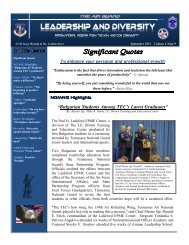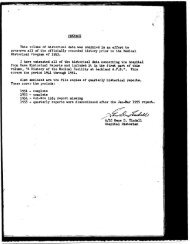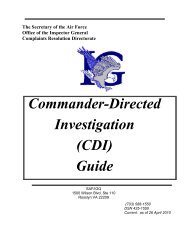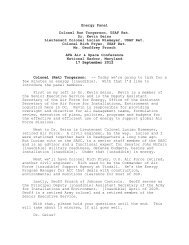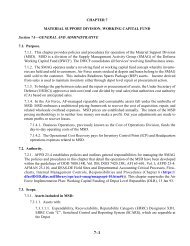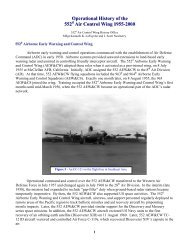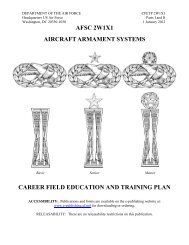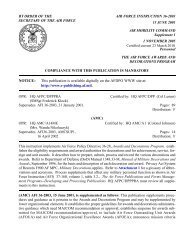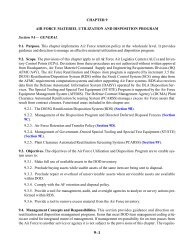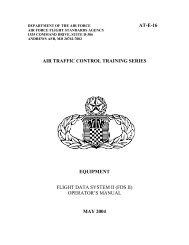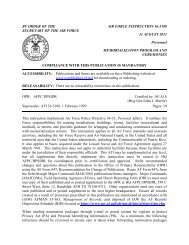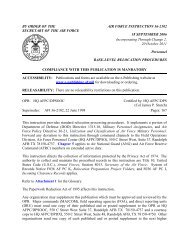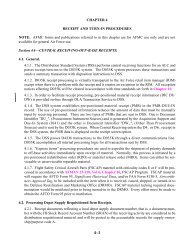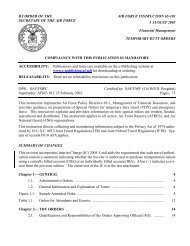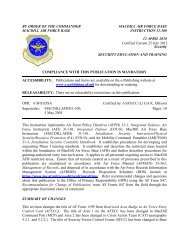MAGAZINE OF THE UNITED STATES AIR FORCE - Air Force Link
MAGAZINE OF THE UNITED STATES AIR FORCE - Air Force Link
MAGAZINE OF THE UNITED STATES AIR FORCE - Air Force Link
Create successful ePaper yourself
Turn your PDF publications into a flip-book with our unique Google optimized e-Paper software.
(left) Master Sgt.<br />
Nate Bettisworth<br />
and Tech. Sgt.<br />
Holly Mays log the<br />
Thunderbirds aircraft<br />
maneuvers during an<br />
air show. The enlisted<br />
members of the<br />
Thunderbirds team<br />
ensure each show<br />
runs smoothly from<br />
the ground, as well as<br />
in the air.<br />
(top right) The<br />
Thunderbirds fly in<br />
formation during a<br />
show at Lackland <strong>Air</strong><br />
<strong>Force</strong> Base.<br />
(bottom right) A<br />
crew chief performs<br />
a final post-flight<br />
inspection after the<br />
Lackland air show.<br />
26<br />
three-year assignment with the<br />
Thunderbirds is over.<br />
“They bring back that pride and<br />
professionalism that is here every<br />
day,” Chief Mical explained.<br />
Knowing the rest of the team<br />
takes such pride in its work is especially<br />
important to the Thunderbirds<br />
pilots, who trust the maintenance<br />
team to provide them with safe<br />
aircraft.<br />
“We make sure the pilots can<br />
walk out to the aircraft, pop in<br />
and go,” said Staff Sgt. Nathan<br />
Kearns, a Thunderbirds crew chief.<br />
“Unlike any fighter squadron in the<br />
<strong>Air</strong> <strong>Force</strong>, [the Thunderbird pilots]<br />
do not do a typical walk-around<br />
inspection as a normal fighter pilot<br />
would. They put faith in us that<br />
we’re doing our job so they can<br />
come out and do theirs.”<br />
Once all necessary maintenance<br />
is performed on one of the<br />
Thunderbirds’ 11 F-16 Fighting<br />
Falcons, an assistant crew chief<br />
inspects the aircraft and fills out the<br />
required forms. After that, a crew<br />
chief performs his own inspection<br />
and ensures the forms are accurate.<br />
Finally, the production superintendent<br />
completes an inspection<br />
and signs the paperwork, officially<br />
declaring the aircraft as being ready<br />
for flight.<br />
www.<strong>AIR</strong>MANonline.af.mil<br />
photo by Staff Sgt. Jamie Powell<br />
“It adds pressure that [the pilots]<br />
don’t perform pre- or post-flight<br />
walkarounds,” Sergeant Kearns said.<br />
“Maintaining a $30 million aircraft<br />
and having the pilot’s life in our<br />
“maIntaInIng a $30<br />
mIllIon aIrCraft and<br />
havIng the pIlot’s<br />
lIfe In our hands<br />
Is stressful, I won’t<br />
lIe, but It’s somethIng<br />
we’ve traIned for.”<br />
— Staff Sgt. Nathan Kearns<br />
hands is stressful, I won’t lie, but it’s<br />
something we’ve trained for.<br />
“We go so far as ensuring every<br />
switch in that cockpit is set up for<br />
how that individual pilot wants it,”<br />
he added.<br />
Ensuring every member on the<br />
team is properly trained is vital<br />
because the maintainers are tasked<br />
with another responsibility that<br />
involves homeland defense. If <strong>Air</strong><br />
<strong>Force</strong> commanders need the F-16s<br />
back in the fighting inventory, the<br />
maintainers must quickly return<br />
them to full fighting capability,<br />
Sergeant Kearns said.<br />
“We have a 72-hour time scale to<br />
return these aircraft to full-combat<br />
capability, which has been tested,”<br />
he said. “We did it in about 40<br />
hours, minus the paint scheme.<br />
So these aircraft could definitely<br />
be ready if, God forbid, that ever<br />
happens.”<br />
While the pilots depend on the<br />
maintainers to help them do their<br />
jobs, there are <strong>Air</strong>men behind the<br />
scenes, supporting both the pilots<br />
and maintainers in completing their<br />
mission.<br />
“Our team is made up of a lot<br />
more than just the maintenance<br />
career fields,” Chief Mical said. “We<br />
have about 32 different career fields<br />
that range from finance, material<br />
management, air transportation,<br />
knowledge operations, client systems,<br />
RF transmission systems and<br />
public affairs.”<br />
Those team members also exhibit<br />
the Thunderbirds’ team-first mentality<br />
as they upload and download<br />
equipment from the aircraft the team<br />
travels aboard while the maintainers<br />
work on getting the F-16s ready for<br />
flight, Sergeant Davis said.<br />
“Everyone has a purpose,<br />
whether it’s a crew chief or a finance<br />
[<strong>Air</strong>man]. Everyone has a purpose<br />
to be here and everyone works<br />
together,” he said. “It allows us to be



